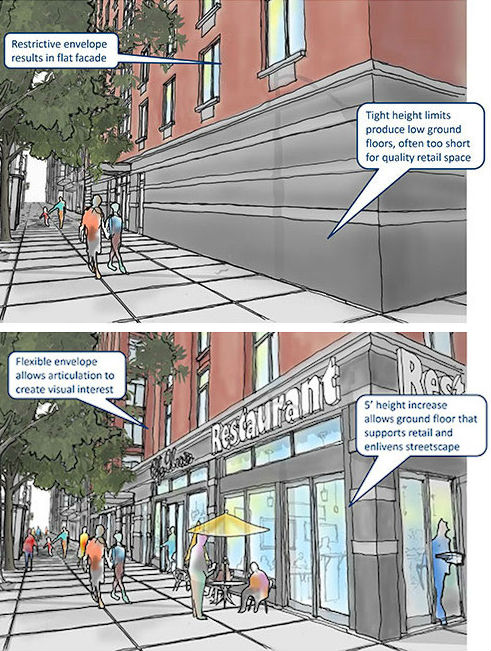![Parking requirements for affordable and senior housing have already been eliminated in the dark grey areas. Under the mayor's plan, they would also be eliminated in a new "transit zone," shown in purple. Map: DCP [PDF]](https://lede-admin.nyc.streetsblog.org/wp-content/uploads/sites/48/2015/09/DCP_transit_zone.png?w=689)
In February, the Department of City Planning outlined the broad strokes of how the de Blasio administration will seek to change the rules that shape new development in New York. After eight months of public meetings and behind-the-scenes work, City Hall's proposals were released this week. The documents reveal details of how the city wants to handle parking minimums in new residential buildings, and it looks like incremental progress, not a major breakthrough, for parking reform.
Mandatory parking minimums, which require the construction of a certain amount of car storage in new buildings, have been in the zoning code since 1961. Multiple studies have shown that they drive up the cost of housing and increase traffic. The de Blasio administration is proposing to reduce parking requirements near transit, but primarily for subsidized housing, not the market-rate construction the city expects to account for most new development.
Perhaps the biggest change in the plan, called Zoning for Quality and Affordability, is the creation of a "transit zone" covering most land that allows new multi-family housing within a half-mile of a subway line.
Within the transit zone, off-street parking would not be required for new public housing, senior housing, or apartments reserved for people earning below a certain income. Buildings that include a mix of market-rate and subsidized housing could apply for a special permit to reduce or eliminate parking requirements on a case-by-case basis [PDF].
Existing parking could also be removed: Senior housing will be allowed to take out parking without needing any approvals, but other types of affordable housing would require a special permit to get rid of existing parking.
There are plenty of holes in the transit zone. Most of Bay Ridge and Dyker Heights has long been excluded from the map, despite access to the N and R trains. An earlier map included much of the Rockaways, which was later dropped, and sections of Eastchester in the Bronx were also dropped. In Queens, large sections of Woodhaven and Ozone Park are excluded from the transit zone, despite being adjacent to the A and J trains, because zoning in that area is slightly less dense than nearby sections of Brooklyn.
Outside the transit zone, things mostly stay the same. Parking mandates will even remain for most subsidized housing. One change: The required parking ratio for senior housing, which is as high as 35 parking spots for every 100 residences, will be lowered to a flat 10 percent outside the transit zone.
Market-rate units, both inside and outside the transit zone, will see no change to existing parking requirements.
Eliminating parking mandates for affordable and senior housing near transit, where few residents own cars to begin with, is a common-sense step that will enable the construction of more homes. “We have thousands and thousands of low-income seniors on our wait lists for housing," Catholic Charities of Brooklyn and Queens, NYC's largest low-income senior housing developer, said in a DCP presentation [PDF]. "We do not have a single wait list for parking.”

Ideally, parking requirements would simply be eliminated everywhere, but that would require DCP to shift its philosophy and acknowledge that forcing new development to match existing car ownership rates is detrimental to the city.
In addition to changes to parking requirements, the proposal also tweaks other rules, with the goal of improving the streetscape and pedestrian experience:
- Buildings in most medium- and high-density districts would be allowed up to five additional feet on the ground floor. This extra height makes the ground floor more appealing for retail. Even without shops, it can help make the streetscape more attractive by moving apartments slightly above the sidewalk level.
- Buildings would be encouraged to include bay windows, courtyards and other features to provide some variety to the streetscape and discourage flat building walls.
- Buildings would also be encouraged to line up with their neighbors, creating a consistent street wall and a more pleasant walking environment.
DCP also released its East New York plan this week. Manhattan Community Board 4 chair and parking policy watchdog Christine Berthet noticed that the proposal that would no longer allow parking in the front yards of new buildings on most side streets -- a small but important change that can keep residential neighborhoods from getting carved up by curb cuts.
In addition to the Zoning for Quality and Affordability and East New York proposals, the city also released its plan for mandatory inclusionary zoning. The proposals now enter the official public review process [PDF], culminating with a City Council vote after approximately six months.





